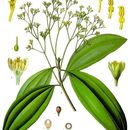Brief Summary
provided by EOL authors
C. aromaticum (formerly C. cassia), cassia or Chinese cinnamon, is a small evergreen tropical tree in the Lauraceae (laurel family), native to Myanmar but now widely cultivated in southeast Asia (including China and Vietnam) for the production of the spice and essential oil obtained from its inner bark and young shoots. Although the name “cinnamon” more properly refers to the related species, C. verum (“true” or Ceylon cinnamon), as well as several other Cinnamomum species, cassia--which has a stronger flavor but is less expensive--accounts for the largest share of the spice marketed as “cinnamon” in the U.S. The names “cinnamon” and “cassia” cause considerable confusion, as they are often used interchangeably. In the U.S., the spice produced from the dried, ground bark of any of these species is referred to as “cinnamon,” without distinguishing among species. In addition, “cinnamon” may also refer to the spice obtained from the aromatic bark of an unrelated species, Canella winterana (in the Canellaceae). The cassia tree grows to around 12 m (40 ft) in height, and has leathery alternate to sub-opposite to opposite leaves, oblong to lanceolate, up to 10 cm (6 in) long, with a long acuminate tip (tapering to a point). Bark, branches, and leaves all contain aromatic compounds. The small white flowers are either unisexual or bisexual (perfect), and generally occur in axillary panicles (clusters that grow where leave join to branches). The fruit is a small, fleshy berry, about 1 cm (0.25 in) long, that ripens to dark purple, partly surrounded by a cup-like perianth (developed from the outer parts of the flower). The spice form of cassia is obtained by removing the outer bark of the tree, and scraping from it the inner bark, which is dried and ground into power. Cultivated trees may also be coppiced (cut back to encourage shoot development), so that the coppiced shoots can be harvested. Buds are also used. Cassia oil is steam distilled from the leaves and twigs. Cassia and other forms of cinnamon have been used since ancient times (noted in Sanskrit texts and in the Bible, as well as in accounts by Herodotus and Pliny) for their sweet and somewhat spicy flavor. It is widely used to flavor baked goods, puddings and other desserts, and candies, as well as soups and stews, curries, meat and poultry dishes, and pickles. Cassia is also used to flavor beverages, including teas and mulled wine. The buds, which look similar to cloves (Syzygium aromaticum), are used in pickles, marinades, and teas. FAO estimates that total commercial production of all forms of cinnamon (derived from several species of Cinnamomum, including C. aromaticum, as well as canella (Canella winterana) was 155,000 metric tons, harvested from 186,000 hectares. China, Indonesia, Sri Lanka, and Vietnam together produced around 98% of the world’s total. (Bailey et al. 1976, FAO 2012, Flora of China 2012, Hedrick 1919, van Wyk 2005.)

